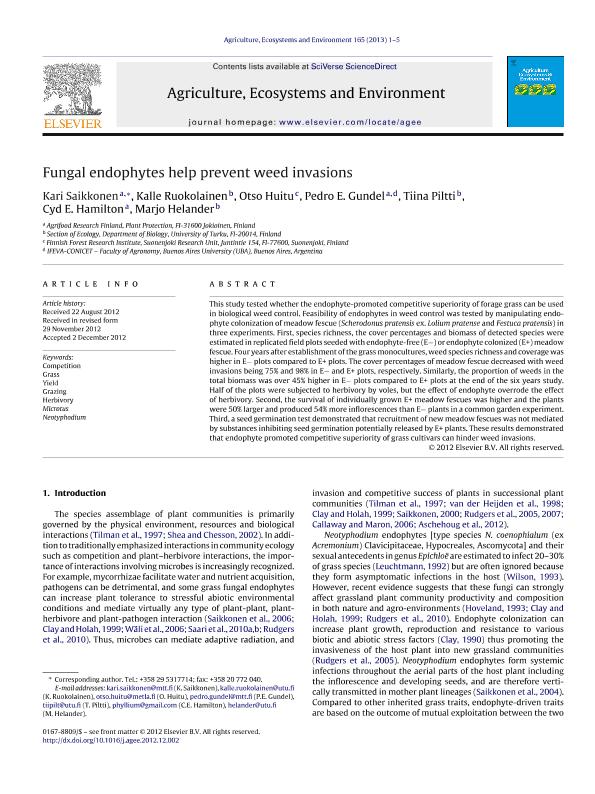Artículo
Fungal endophytes help prevent weed invasions
Saikkonen, Kari; Ruokolainen, Kalle; Huitu, Otso; Gundel, Pedro Emilio ; Piltti, Tiina; Hamilton, Cyd E. ; Helander, Marjo
; Piltti, Tiina; Hamilton, Cyd E. ; Helander, Marjo
 ; Piltti, Tiina; Hamilton, Cyd E. ; Helander, Marjo
; Piltti, Tiina; Hamilton, Cyd E. ; Helander, Marjo
Fecha de publicación:
01/2013
Editorial:
Elsevier
Revista:
Agriculture, Ecosystems and Environment
ISSN:
0167-8809
Idioma:
Inglés
Tipo de recurso:
Artículo publicado
Clasificación temática:
Resumen
This study tested whether the endophyte-promoted competitive superiority of forage grass can be used in biological weed control. Feasibility of endophytes in weed control was tested by manipulating endophyte colonization of meadow fescue (Scherodonus pratensis ex. Lolium pratense and Festuca pratensis) in three experiments. First, species richness, the cover percentages and biomass of detected species were estimated in replicated field plots seeded with endophyte-free (E−) or endophyte colonized (E+) meadow fescue. Four years after establishment of the grass monocultures, weed species richness and coverage was higher in E− plots compared to E+ plots. The cover percentages of meadow fescue decreased with weed invasions being 75% and 98% in E− and E+ plots, respectively. Similarly, the proportion of weeds in the total biomass was over 45% higher in E− plots compared to E+ plots at the end of the six years study. Half of the plots were subjected to herbivory by voles, but the effect of endophyte overrode the effect of herbivory. Second, the survival of individually grown E+ meadow fescues was higher and the plants were 50% larger and produced 54% more inflorescences than E− plants in a common garden experiment. Third, a seed germination test demonstrated that recruitment of new meadow fescues was not mediated by substances inhibiting seed germination potentially released by E+ plants. These results demonstrated that endophyte promoted competitive superiority of grass cultivars can hinder weed invasions.
Palabras clave:
Competition
,
Grasess
,
Yield
,
Grazing
Archivos asociados
Licencia
Identificadores
Colecciones
Articulos(IFEVA)
Articulos de INST.D/INV.FISIOLOGICAS Y ECO.VINCULADAS A L/AGRIC
Articulos de INST.D/INV.FISIOLOGICAS Y ECO.VINCULADAS A L/AGRIC
Citación
Saikkonen, Kari; Ruokolainen, Kalle; Huitu, Otso; Gundel, Pedro Emilio; Piltti, Tiina; et al.; Fungal endophytes help prevent weed invasions; Elsevier; Agriculture, Ecosystems and Environment; 165; 1-2013; 1-5
Compartir
Altmétricas



